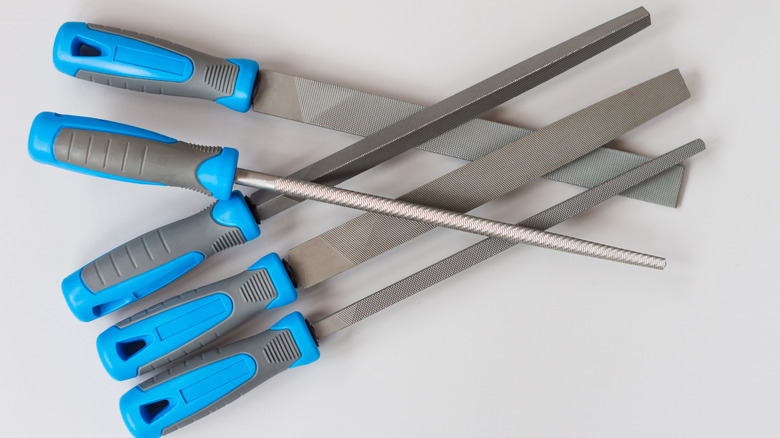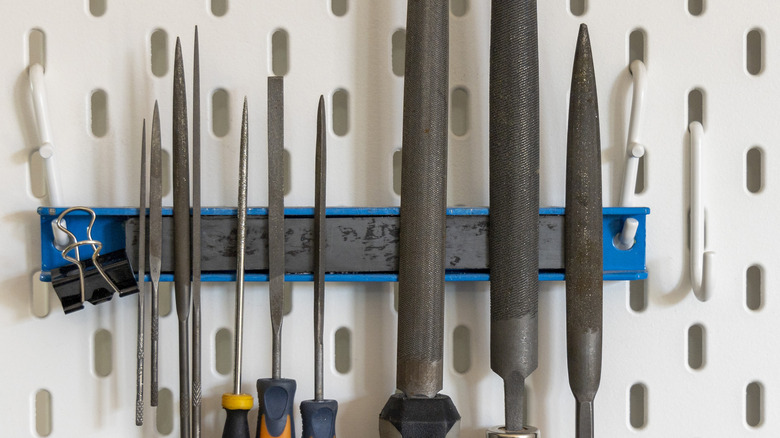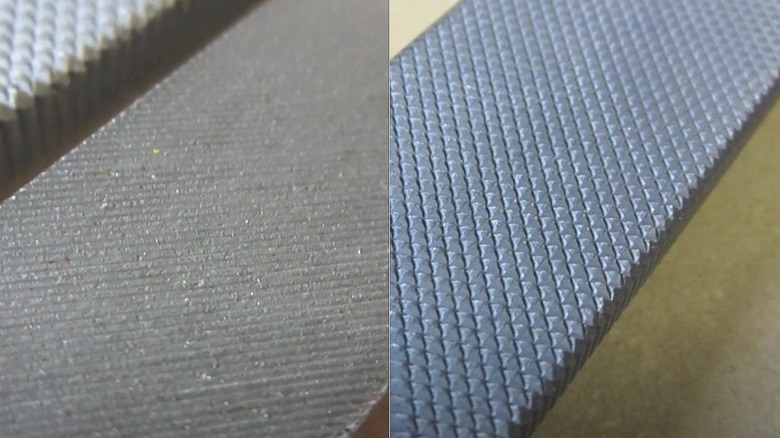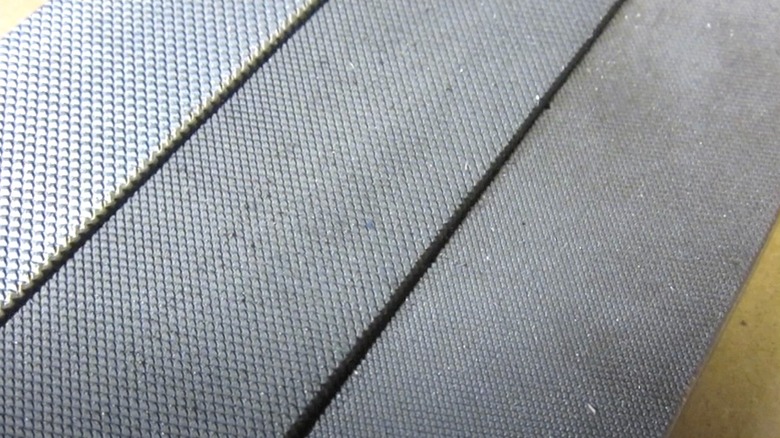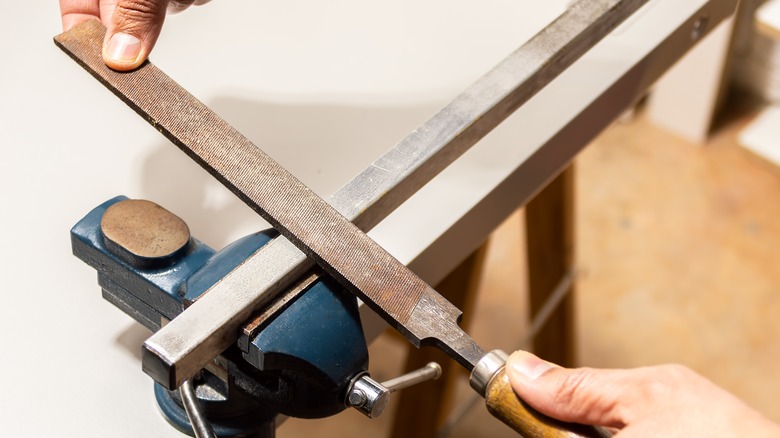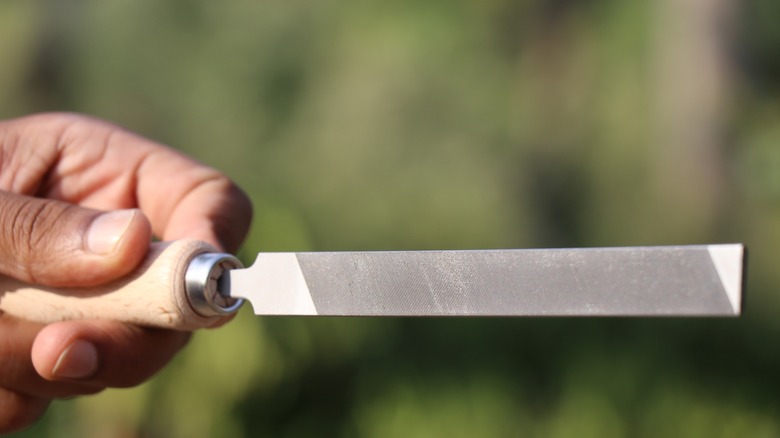Tips For Choosing The Right Metal File For Every Job
We may receive a commission on purchases made from links.
A metal file is exactly what the name suggests — a thin, metal tool used for filing down or giving a finishing edge to other metals, wood, ceramic, certain types of rubbers, and other materials. Metal files are also incredibly useful for keeping your power tools nice and sharp, along with descaling, sculpting, deburring, and sharpening kitchen shears and knives. At first glance — especially if you're unfamiliar with this tool — all metal files might appear very similar. However, files come in different shapes, sizes, levels of coarseness, contours, and types of cuts. Additionally, different metal files have varying applications, and some types of files are more effective at certain projects than others.
While that may sound confusing, you can typically decide which type of file you need to use based on the shape of the surface you want to shave down or finish. Cut types, coarseness grades, and contours are equally easy to navigate. Below, we'll show you how to find the most suitable file for your project.
Round files, needle files, and triangle files, oh my!
While metal files have many different classifications, one of the broadest classifiers is the file type. Some of the most common types of files that are suitable for beginners to the tool are flat files, half round files, triangle files, round files, and needle files. Luckily, understanding these file types is fairly intuitive. Flat files are flat on both sides, while half round files are round on one side and flat on the other. Triangle files are shaped like a triangle with three coarse edges, round files have a cylindrical shape, and needle files are long and pointed.
When deciding what type of file to attack your project with, consider the shape of the surface you're working on. If you need to file or shape a large, even surface, a flat file is your best friend. For cylindrical objects like jewelry, pipes, or any other rounded shape you need to work on, you'll want to use either a half-round, round, or a needle file, depending on the thickness of the surface. Finally, triangle files are great for working on angles and notches.
How to choose between a double- and a single-cut file
Another classifying factor for files is whether they're double cut or single cut. Like file type, cuts are also rather intuitive. Single-cut files have just one set of parallel cuts running down their side in one diagonal direction. On the other hand, double-cut files have two sets of cuts running in opposing directions, forming a crosshatch pattern.
The little ridges between the cuts of files are known as teeth, and these give files their coarse edges for abrasion and sharpening. Typically, single-cut files are much smoother and better for finishing jobs. Since double-cut files are coarser, they are used for shaving down larger amounts of material, so they work best if you don't require much precision. When deciding between single- and double-cut files, consider the type of work you'll be doing. If you need the tool for heavy duty tasks, like sharpening a dull shovel, you're going to want a double-cut file. Meanwhile, single-cut files are better suited for more delicate jobs, like giving your knife or saw blade a new, razor-sharp edge.
Know what coarseness grade you need to get the job done
Beyond the number of cuts, another important classifier to understand when deciding on the type of metal file is the coarseness grade, which refers to the spacing between the teeth. Metal files are typically broken down into three different grades for coarseness: smooth cut, second cut, and bastard cut. The softest grade is the smooth cut. Files with a smooth cut are best for sanding and finishing. Second-cut-grade files are coarser than those with smooth cut and are capable of shaving but still suitable for finishing work. The bastard cut is the coarsest and most abrasive grade of file. It's best for working with rough metal surfaces that require you to shave away large parts of the material and where achieving a smooth finish isn't the goal.
A second-cut file coarseness grade should serve you well in most applications. It's a great option if you're only going to purchase one metal file, as you'll be able to use it for both your shaving and finishing needs. That said, as a rule of thumb, you should always select a coarser file for heavier-duty jobs and a smoother grade for light finishing.
Pick a file with the right contour
In addition to file types, cuts, and coarseness grades, one more factor to consider when choosing a file for your job is the contour. File contours refer to the profile of the tool, which can be blunt or tapered. If it's a blunt file, its edges are completely straight and have a uniform width from the handle to the tip. Meanwhile, files with a tapered contour have long edges that converge at the tip of the tool and are typically thicker closer to the handle.
If you're planning on using your metal file on simple, flat surfaces, you're probably fine with a blunt metal file. On the other hand, tapered files are more useful for fitting and filing unique shapes, like grooves and corners. Tapered contours also extend the versatility of your file, since you can easily alternate between the wider and narrower parts of the tool. So, when you work on objects with tight nooks and crannies, a tapered-contour file is a better option than the blunt type.
Best all-around file types for beginners
If you want to acquire several metal files to fit most of your needs, some of the best choices are flat files, round files, and half round files. A double-cut flat file with a second grade of coarseness is a safe bet for the majority of projects if you're new to using files. You can easily take these tools to any large, flat surface; however, they'll help you shape larger, convex surfaces as well.
It doesn't hurt to have a round or needle file with medium coarseness in your tool kit, too. These are handy when filing out holes for mounting appliances, shaping the insides of pipes, and even fixing a misaligned door latch. However, you can also accomplish these tasks with a half round file, so you can stick with that if you're on a budget. Now, if you only want to purchase a single file, consider a double-cut, second grade, half-round type, like this Crescent Nicholson 12-inch file. You'll be able to use this tool on both flat and rounded items for shaving and finishing work.
